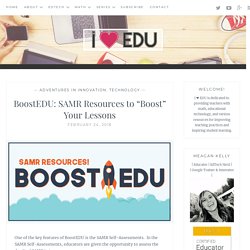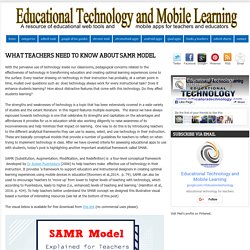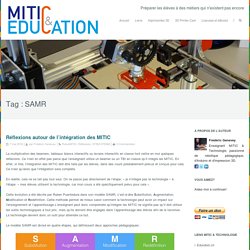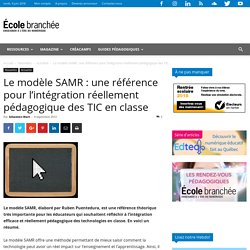

SAMR Model Explained. What the SAMR Model May Be Missing. Personalized learning technologies can, ironically, make the learning experience less personal, less human.

That perspective is rooted in my experience teaching in Silicon Valley, using some of the same digital apps and tools that are popular in classrooms today. Despite my criticisms and sour experiences, I don’t believe that all education technology is bad. When designed and used appropriately, these tools can, in fact, help to make learning experiences more personal for students, in a way that humanizes the learning experience. To guide us in building and implementing technology thoughtfully, I’d like to build upon a framework that is already popular among many education technologists. A Crash Course in SAMR Developed by Dr. In the lower steps of this model—Substitution and Augmentation—technology integration is seemingly less sophisticated. The latter two steps of the model—Modification and Redefinition—are categorically different.
When SAMR Isn’t Enough 1. 2. 3. 4. Developed by Dr. 1. Using The SAMR Model To Frame How To Teach With Apps. SAMR Model Explained for Teachers. BoostEDU: SAMR Resources to “Boost” Your Lessons. One of the key features of BoostEDU is the SAMR Self-Assessments.

In the SAMR Self-Assessments, educators are given the opportunity to assess the depth of SAMR in two ways: In-Depth SAMR Self-Assessment is used to analyze the depth of SAMR in specific areas of a lesson. Educators will receive an editable Google Doc to add ideas for future lessons.Basic SAMR Self-Assessment is a short self-assessment that provides educators with the depth of SAMR in their overall classroom. Personally, I really love the In-Depth SAMR Self-Assessment due to the depth that educators can evaluate their lessons and how it gives them a step towards boosting their old lessons.
One of the great benefits of this self-assessment is the instructional strategy and tech tools suggestions that can be selected and added to a Google Doc. In addition to this self-assessment, I also created a series of Google Docs that contain ALL of the instructional strategy and tech tool suggestions. Ready to boost your lesson? Educational Technology and Mobile Learning: What Teachers Need to Know about SAMR Model. With the pervasive use of technology inside our classrooms, pedagogical concerns related to the effectiveness of technology in transforming education and creating optimal learning experiences come to the surface.

Every teacher drawing on technology in their instruction has probably, at a certain point in time, mulled over questions such as: does technology always work for every instructional task? Does it enhance students learning? How about distractive features that come with this technology. Do they affect students learning? The strengths and weaknesses of technology is a topic that has been extensively covered in a wide variety of studies and the extant literature in this regard features multiple examples. SAMR (Substitution, Augmentation, Modification, and Redefinition) is a four-level conceptual framework developed by Dr Ruben Puentedura (2006) to help teachers make effective use of technology in their instruction. Original post here.
SAMR, un modèle à suivre pour développer le numérique éducatif (par Alain Lévy) What is the SAMR Model and what does it look like in schools? Intégrer la pédagogie des Tice en classe. SAMR - Matrice d'intégration des technologies en image. SAMR – MITIC & Education. La multiplication des beamers, tableaux blancs interactifs ou écrans interactifs en classe font naître en moi quelques réflexions.

Ce n’est en effet pas parce que l’enseignant utilise un beamer ou un TBI en classe qu’il intègre les MITIC. En effet, in fine, l’intégration des MITIC doit être faite par les élèves, dans des cours préalablement prévus et conçus pour cela. Ce n’est qu’alors que l’intégration sera complète. En réalité, cela ne se fait pas tout seul. On ne passe pas directement de l’étape: « je n’intègre pas la technologie » à l’étape: « mes élèves utilisent la technologie, car mon cours a été spécifiquement prévu pour cela ». Cette évolution a été décrite par Ruben Puentedura dans son modèle SAMR, c’est-à-dire Substitution, Augmentation, Modification et Redéfinition. Le modèle SAMR est divisé en quatre étapes, qui définissent deux approches pédagogiques: Pour rendre plus claires ces étapes, voici une petite métaphore: SAMR par C. Rhein (Canopé) Le modèle SAMR : une référence pour l’intégration réellement pédagogique des TIC en classe.
Le modèle SAMR, élaboré par Ruben Puentedura, est une référence théorique très importante pour les éducateurs qui souhaitent réfléchir à l’intégration efficace et réellement pédagogique des technologies en classe.

En voici un résumé. Le modèle SAMR offre une méthode permettant de mieux saisir comment la technologie peut avoir un réel impact sur l’enseignement et l’apprentissage. Ainsi, il aide l’enseignant à comprendre qu’intégrer les TIC ne signifie pas d’utiliser la technologie à tout prix, mais d’engager l’élève dans son apprentissage. La technologie devient donc un outil pour atteindre ce but. Les lettres signifient Substitution, Augmentation, Modification et Redéfinition. Allons voir de plus près chacune des composantes du modèle SAMR, mis en place par Ruben Puentedura.